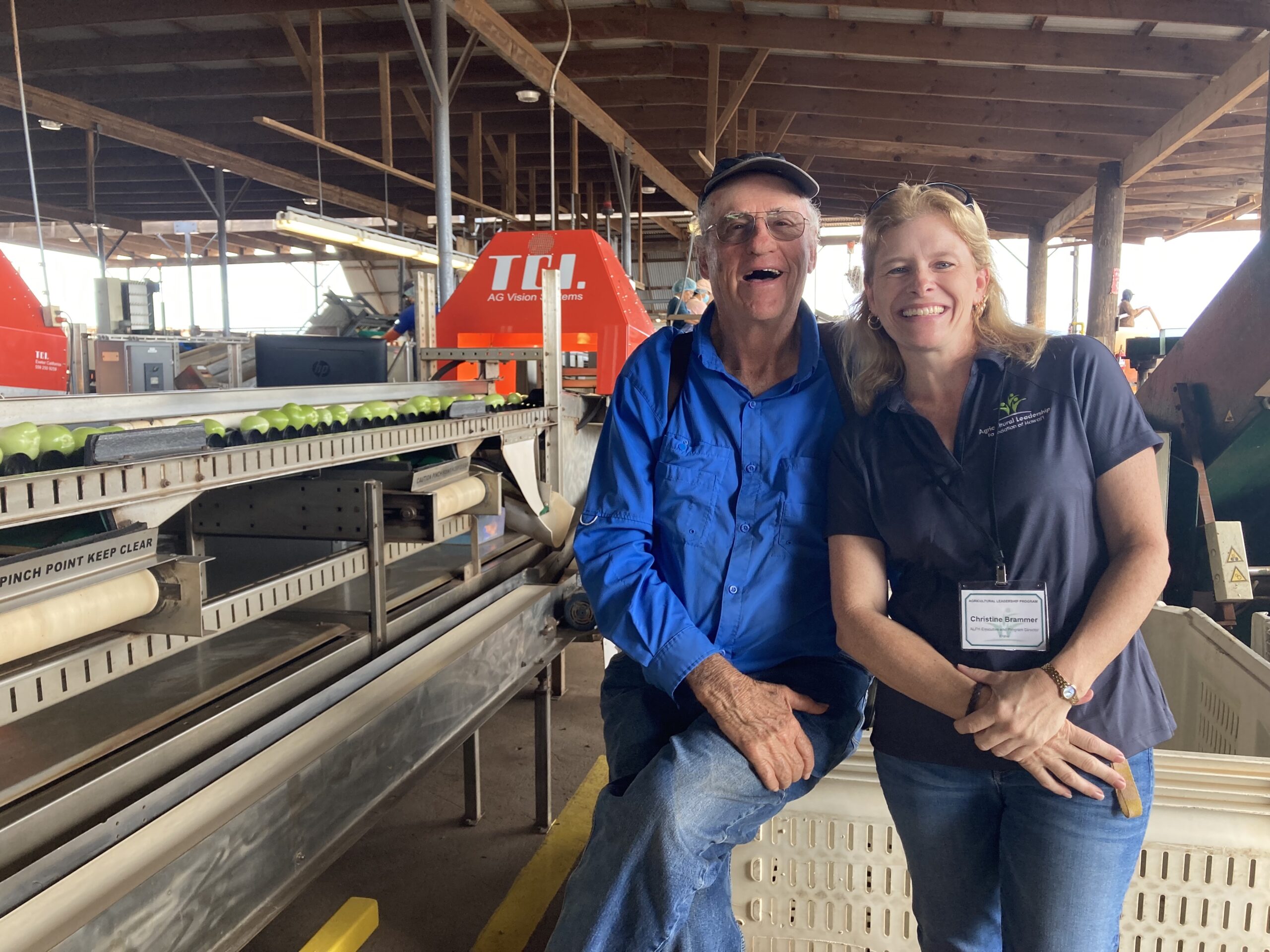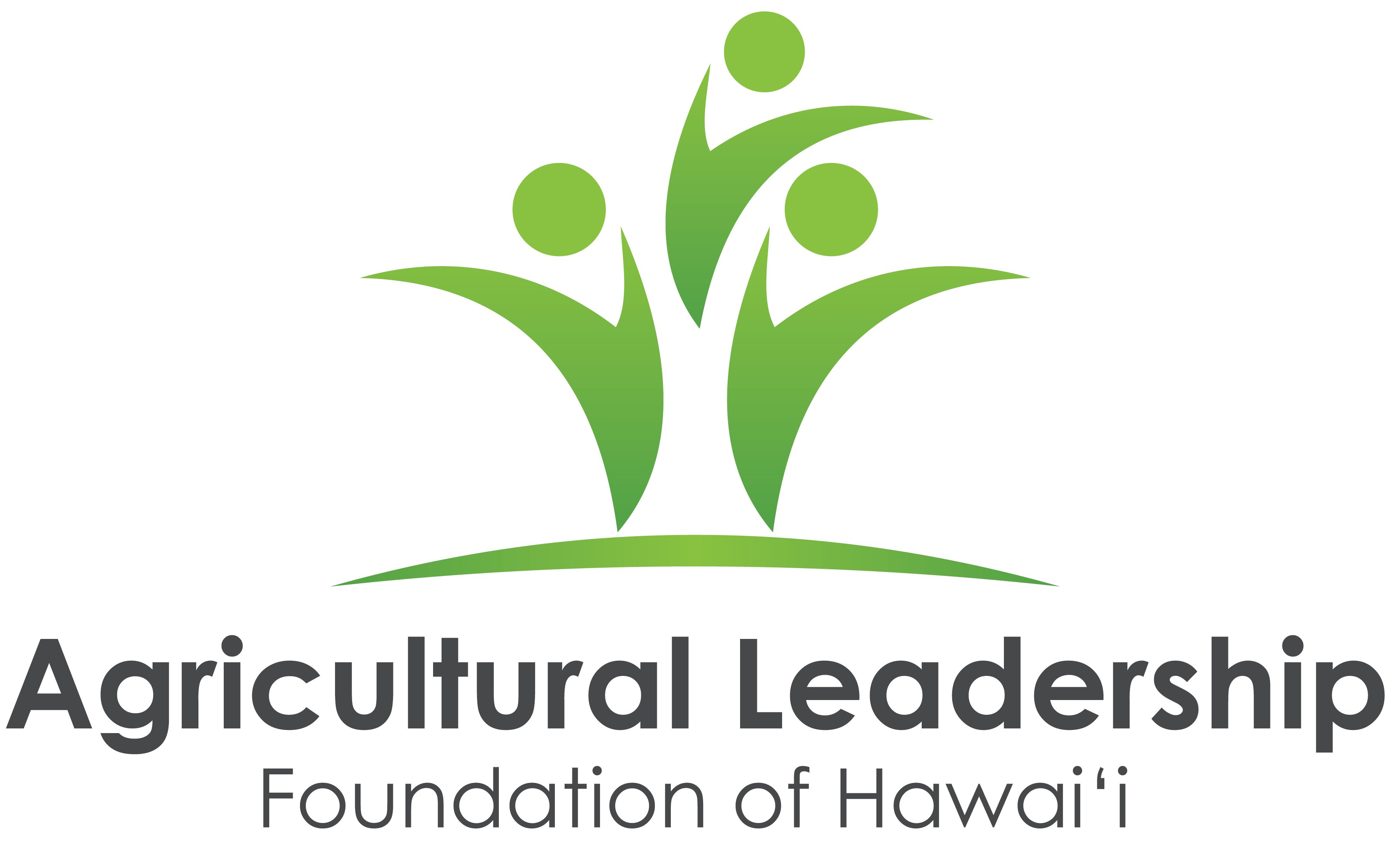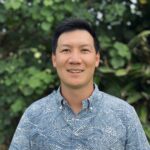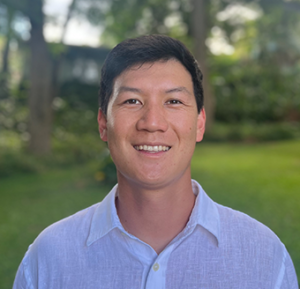




Contributed by Jin-Wah Lau, ALP Class XVIII
Sugarland Growers, Inc. with Larry Jefts – Kunia, O`ahu
Our second seminar finally was here! ALP Class XVIII convened in central O’ahu in Kunia, about twenty miles northwest of Honolulu, with a visit to Sugarland Growers Inc. where we met up with owner Larry Jefts who posed the question, “Are you financially at risk if your crops fail?” With much on the line, Sugarland relies its crop success to pay employees and keep its doors open for business. Larry Jefts’ commitment to agriculture, industry, and the land started with his first crop in 1958 when his Hawai`i farm journey began on the island of Moloka‘i. Today Sugarland’s 2,800 acre farm in Kunia grows watermelon, bell pepper, tomato, cucumber, cabbage, and banana.
Since Jefts’ humble start, Sugarland has grown to 260 in-house employees, is now one of Hawaiʻi’s largest diversified crop operations, and has become the largest distributor of bananas in U.S. sending out 1 million lbs/wk. The site boasts of packing facilities in 6 locations, 23 years of satellite tractor operations accurate to a millimeter, and large-scale machinery engineered specific to crop.
Most everything from taxes to electrical and mechanical repairs are done in-house to help with efficiency. Sugarland even does their own distribution on their downtime and sometimes are paid for produce delivery when requests are for specific times. Jefts’ noted a minimum 4.712% cost savings on sales tax when labor is not contracted out. They "size" for 80-90% of the market, not 105%. Jefts added, "We grow what we know we can sell" before we tour his USDA-approved open air packhouse that supplies to Costco, Safeway, Subway, Wendy’s, McDonald’s, and Jack-in-a-Box. “The customer drives the market” is Jefts’ saying even when it comes down to selecting what they grow. Sugarland’s biggest tomato purchasers are fast food companies who use slicers, so Jefts responded by growing the ‘Roma’ variety which fits the fast-food tomato criteria to a T - a firm, red fruit with minimal juice.
Jefts has sold his crops as far as Canada and Guam but finds a correlation between distance and ease of payment with collection being easier when the customer is closer. From experience, produce from Sugarland is not often shipped out of state, keeping costs down by reducing overhead and freight charges, reducing the company’s carbon footprint, and passing savings on to customers. Despite having more rules when it comes to selling big, Sugarland’s customer preference is big box clubs, major supermarkets, fast food, and military commissaries because they always pay, pay more, and pay on time.
In respect to workforce, Jefts said that since Covid, the struggle to find consistent farm labor has been challenging even though there are ample benefits as an employee at Sugarland. When asked about collaborating to uplift and stabilize the industry, Jefts commented that there’s less collaborating now because the new wave of farmers don’t have the camaraderie and investment in the system moving together. Jefts, who no longer confides in the University of Hawai`i for crop assistance, says connection is important. Sugarland’s out-of-state partners include Cal Poly San Luis Obispo, Universities of Florida and Texas, and “the folks in Gainesville, Florida,” who work to increase efficiency and production, exchange information, resources, and contribute to agricultural research and development. Jeft also loves YouTube.
In two vehicles we drove around the property to see the inner workings of this very efficient farm that we have all consumed produce from. Wherever we visited, employees were focused on doing their part on the production line: transporting banana bunches on ATV, cutting bananas from the stalk, setting pinworm lures on the tomato, or moving boxed tomatoes off the tomato processing line into coolers. Sugarland employees were busy! Highlights from the farm visit included the banana processing plant (a.k.a “banana spa”), mechanics’ corner, R-1 and R-2 reservoirs, cover crops of oats, in-field tomatoes, and the tomato processing area. As we hypnotically stared at the sorting and packing process of green and orange tomatoes moving quickly on the assembly line, Jefts reminded us that the property-engineered, crop specific machinery and tools were the strength of his operation. We ended the tour at the tomato processing plant, inspired that a farm-for-profit is still possible in Hawai`i’s busy economy.
Kunia Country Farms and Kō Hana Hawaiian Agricole Rum with Jason Brand – Kunia, O`ahu
Our next stop was Kunia Country Farms and Kō Hana Hawaiian Agricole Rum where we met with co-founder Jason Brand. We began our tour at Kunia Country Farms, a 3-acre aquaponics system of floating lettuce trays. Here, Brand highlighted the balance between sustainability and community with profit and production where “Buy local for the same price” is the motto.
Kunia Country Farms offers organic-principled grow practices, a talented but minimal farm crew, an environmentally sound system, and a drive to supply the community with locally grown food and education. Sustainability was highlighted through “Zero Impact Farming,” which Brand clarified is farming with the smallest impact on the environment. Some examples of Zero Impact at Kunia Country are net power zero (mostly solar powered), water neutral (typically no water is added because evaporation is minimal), and soil neutral (minimally invasive to the land).
Brand described competitive advantage of growing lettuce year-round in the sunny central O`ahu versus growing in California and shipping to Hawai`i, and highlighted reducing cost in production while sustaining his ethics to match the competitive global market. However, Brand says if he were to do it over, berries would be his crop of choice not lettuce since berries are heavily imported, widely consumed, and go bad quickly in Hawai`i.
The 3-acre aquaponic lettuce farm that’s gravity-fed from a tank full of tilapia turns out 5,000 lbs of lettuce/week. From a state that has 91.7% of its lettuce flown in from over 2,000 miles away, the lettuce farm is a small but meaningful step toward food independence and embodies Kō Hana and Kunia Country’s commitment to serving our Hawai`i community.
Besides Zero Impact Farming, there are no fertilizer inputs added into system to produce lettuce. Rather, fish chow that’s fed to the tilapia are excreted out as nutrient-rich fertilizer that lettuce plants can then “filter” and consume. After biological filtration, a physical filtration occurs, followed by UV water treatment before being cycled back to the fish. The water is purportedly safe to drink before it cycles back to the fish after some 6 hours in the system, but Brand says he’s never personally tested. To close the loop further, Brand is assessing locally produced bycatch and black soldier flies to substitute for imported fish chow so that both fish and plants are fed products produced on island. Even though the cost is at least double of having fabricated and shipped their floating Styrofoam lettuce trays to Kunia, trays are made to spec in Kapolei. Brand insists on supporting local business because “at the end of the day we are asking them if they can support a local business?”
Brand plans to expand his production target to 50,000 lbs of lettuce/ week at which point they’ll be able to set market prices instead of just being undercut by California prices. Having this much of a market share will take away 6.5% of the 91.7% of local lettuce market and, if Kunia Country Farms can train 9 other farms on their production practices, a majority 65% share of the lettuce industry in Hawai`i will be locally grown. This collaboration will give enough market shares to get market prices down for local products and produce.
Kunia Country Farms’ goal is to grow big enough to be a constant supplier. Currently, their products are sold to the Hawai`i Department of Education, grocers, and the Hawai`i Food Bank, and 15% of their lettuce is gifted to Lanakila, the Hawai`i Foodbank, and other community partners. While lettuce hits the local markets, rum is Brand’s export crop.
From here we walked back to the Kō Hana side to learn about Brand’s sugarcane and rum operations. From the shiny distillers out in front to the layout of their tasting room and unique square bottles with handwritten batch numbers, it’s apparent a lot goes into Kō Hana’s agricole rum. While lettuce takes 8 weeks of crop planning from seed to sale, rum takes 3 years of planning before the product is sellable. The rum side is what Brand refers to as “ag for export” and brings economic sustainability for Kunia Country Farms aquaponics operation. The cane is hand-harvested, pressed to juice, fermented, distilled, then rested or aged on-site.
Kō Hana Hawaiian Agricole Rum (Kō Hana means “work of the sugar cane”) is an agricole-style rum made from the fresh juice of several different Hawaiian heirloom cane varieties. With help from Noa Lincoln and Hawai`i Agriculture Research Center (HARC), spotlighted in Kō Hana rum are 34 heirloom canoe varieties of sugarcane genetically verified as native Hawaiian that Kō Hana grows and harvests from their living collection.
The cane varieties each have a unique outward appearance, ranging from red to green, pink or orange, to purple, with or without stripes. Seeing the array of heirloom varieties next to each other, it’s apparent why these are not conducive to modern sugar operations. Erratically segmented, growing in a peculiar directions with variation in growth patterns, mechanized harvesting done by the plantation is not an option here. Diameters are variable as is node length, but many of the heirloom canes are also fatter than cane we’re accustomed to seeing. According to Brand, each variety has its own individual flavor and color, creating unparalleled, pure flavored rums that “honor the land and the significance of each varietal.”
Co-owner Jason Brand bashfully explains that his foray into producing sugarcane-derived alcohol began as a biodiesel project, but pivoted to rum when he discovered the potential of native Hawaiian sugar cane. To produce agricole rum, fresh squeezed sugarcane juice is the base ingredient as opposed to molasses in standard rum. To put the fresh in their agricole rum, Kō Hana cultivates their own sugarcane and is the largest sugarcane grower in the state of Hawai`i. Brand says that farming the cane is “the most uneconomical part of business” and must remind himself “why we farm and why we do it, and remind ourselves of story of plants, people, and history.” Fortunately for Kō Hana, who makes small batches averaging 400 gallons rum/day, agricoles have always commanded a higher price in the marketplace than molasses-based rums. When Kō Hana got on the Forbes 21 Must-Try Rums list and made #9 in the world and #1 in U.S., Jason Brand knew he was in business.
Did you know that Hawai`i is the 7th most rum drinking state? Our visitors love mai tais. Before Kō Hana, 186,000 cases were purchased from the Caribbean-derived rum, but things are shifting as Kō Hana flourishes. Brand said Kō Hana recently signed on with Hawaiian Airlines (that was purchased by Alaska Airlines the day before we visited) to supply single-serve mai tais on all their Hawai`i flights. And Brand plans to double workforce with the expansion of business.
Our last part of the tour was to the barrel warehouse. While mostly American oak barrels are used for aging their rum, Kō Hana has added koa barrels to their racks. That’s right, koa - the prized endemic hardwood of Hawai`i. “For every barrel made, 50 trees are planted,” according to Brand who is planning a long-term restoration initiative that will return seven acres in Kunia back to native forestland. Whether aged or rested, the agricole rum will eventually make its way into the artisan glassware reminiscent of fine cologne or mixed into ready-to-drink cocktails. Our cohort was invited into the tasting room but our lunch from Taqueria El Ranchero and Stevie Whalen were waiting, so we boxed up 6 misty cocktail mixes to save for Wednesday’s dinner at Donna and Skip’s and headed to HARC.
Hawai`i Agriculture Research Center with Stevie Whalen – Kunia, O`ahu
Hawai`i Agriculture Research Center (HARC)’s Research Station lies in the center of the farming community that was once dominated by a Del Monte pineapple plantation. We caught up with HARC Executive Director Stevie Whalen, previously a scientist for the sugar plantation, who provided us the history of HARC and an understanding of their current project to develop a farm community that provides low-income housing and facilities for agricultural workers.
HARC was originally the research arm of Sugar Planters Association of Hawai`i and what was left of the operation at the end of their trust. Whalen recalled with fondness the “thrilling research” and development piloted during the time of the Sugar Planters’ Association which, just for drip tubing, included: first drip irrigation brought to Hawai`i, engineered drip irrigation with ridges, and tubing impregnated with pesticide to kill ants. HARC’s research on sugarcane spanned internationally and was uniquely tested on plantation lands in Hawai`i. Since the decline of the industry, the folks at HARC share the same mission, to achieve practical solutions and identify new agricultural opportunities through applied science, but most recently have added to expand housing and training for workers in agriculture to their mission. The HARC building currently showcases library archives, internal publications in diversified agriculture, and a windowed lab to view the research without contamination.
Whalen recognized finding and keeping workers as one of the fundamental challenges of a successful agriculture system in Hawai`i, then decoded a solution: part reviving the success of her plantation past and part peek into the future of Hawai`i’s housing crisis. Hawai`i Cane and Sugar (HC&S), according to Whalen, “had a one-of-a-kind business model that included worker housing, utilities, and medical care.” When the sugar industry in Hawaii dissolved, Whalen posed the question, “Why wouldn’t we need housing for diversified agricultural workers?” This profound pivot offers a modelable housing solution to address the ongoing setback of not having adequate farm labor that might just work.
It's an irony that besides Executive Director, Whalen holds the position of Land Manager/Land Developer because in agriculture she has never been on the same side of the fence as land developers. But, her commitment to agriculture as an industry and the lives of the farmers who contribute to ag does not waiver. Under Whalen’s management, HARC created 2 organizations to take care of the development of the agricultural worker community: a title holding company 501c2 named Kunia Village where proceeds go to HARC; and a 501c3 named Kunia Village Development Corporation that can receive grants and donations. HARC’s goal here is to hold the land and keep it dedicated to agriculture in perpetuity. That Whalen can go from chemistry to organizing infrastructure development is amazing feat in itself, but on top of that, under her lead she had the foresight to also made rules to keep the ag village agfocused by: instituting ag employment qualifications and an income cap, keeping the price point affordable for folks in the agriculture industry, selecting parcels that are in close proximity to agriculture employment, and planning for housing expansion when the time comes.
Retiring when her replacement is found, Whalen is a little woman with huge shoes to fill. Her spirit of spawning innovative solutions to some of the most difficult problems of Hawai`i’s agriculture community will always be a driving force in HARC. When the new merch comes out, I for one vote for: “Home is where the HARC is.”
Pa‘ina Hawai`i, LLC with Michael Kohn – Kunia, O`ahu
The purpose of an irradiator is to expose products to irradiation for the purpose of improving the safety of foods and protecting ecosystems by reducing or eliminating microorganisms and insects. Because of Hawai`i’s perfect climate, year-round production of agricultural commodities is possible but also makes a perfect breeding ground for a range of insects, gastropods, plant disease, and other vectors that can decimate crops and natural systems. Irradiation provides a solution to allow growers and shippers to export produce from Hawai`i to regions where pests are an issue for the importer’s agriculture and environment, mainly California. We learned about biosecurity, crops, cost, and the science of irradiation with Michael Kohn, president of Pa‘ina Hawai`i.
Ready-to-ship produce is brought by the pallet to Pa`ina Hawai`i where boxes are unloaded onto the receiving dock. For produce coming from Hawai`i, the main purpose of irradiation is to mitigate fruit flies, potato weevil, and slugs on export fruits and vegetables, explained Kohn. A metal box on wheels, large enough to accommodate two medium-sized crouching adults that holds roughly 32 sweet potato boxes stacked 2x4x4, is dunked into 2- 20’ water baths where they are exposed to gamma rays emissions from radioactive forms of the element cobalt (Cobalt 60) then hoisted out. Kohn upholds that the procedure does not leave trace radiation on the food and is declared safe by the FDA, CDC, and WHO.
Pa‘ina Hawai`i’s irradiator facility can treat 15 different products on a regular basis with exception of avocados because their fatty flesh streaks black when exposed to irradiation making the avocado when cut visually unpalatable. Crops for export that must undergo irradiation prior to shipment include: papaya, mango, sweet potato, banana, dragon fruit, curry leaf, and longan. Besides insect control, according to Kohn, other benefits of raw food products undergoing irradiation are: elimination of foodborne illnesses (Salmonella and E. Coli), preservation, disease control, sweeter food, sprout inhibition, ripening delay, shelf life longevity, and preservation. The phytosanitary treatment costs shippers and growers who export their products to the mainland $3.50/box to irradiate.
Sweet Land Farm with Emma and Eric Bello – Waialua, O`ahu
Often, when we think of the word “farm,” images of roaming animals, silage rolls, verdant fields stretching for miles, and the iconic red barn come to mind. While farms can be rough and rugged, heavy on dirt and driptape, dotted with non-working vehicles and ramshackle structures, some are vistas of unparalleled natural beauty. This is Sweet Land Farm. Secluded on the backroads of Waialua are sweeping fields of lush grazing greens bordered by misty high mountains that provide a utopian backdrop for milking goats, extended family, rainbows, and workers that call Sweet Land their sweet home. After a long day of learning and connecting, our perfect day came to a perfect end at Sweet Land Farm. Met by Emma and Eric Bello, daughter-dad duo and owners of the vertically integrated goat dairy, we learned about milking, cheese-making, keeping agrotourism a lower priority, tasted good stuff, and got to spend time with some very sweet goats.
The Sweet Land team manages just over 86 acres of which 78 acres are leased. Their property includes a creamery with a milk parlor, cheese facility, and walk-in coolers for longevity of the finished product; 3 goat barns; 3 covered equipment storage areas that house the only cut-and-feed wagon in the state; a farm store café where dairy products are single sourced from the happy herd and served up; and 6 red plantation homes for family and workers. Sweet Land Farm most definitely has a sweetness to it.
The grass wasn’t always this green. When the Bellos started, the soil was acidic. It took years of working the soil to cultivate their open pastures for grazing and to be able to harvest their own fresh high-quality forage and silage. Recent disruptions caused by the pandemic and global shipping crisis allowed the Bellos to expand their silage production to ship statewide. Surprisingly their next step isn’t tourism, even though sales of cheese make the highest gross revenue and their site feels perfectly set-up for visitors. It’s hay production. For a location that averages 65% humidity, getting hay down to 18% moisture will be their next challenge.
The goats of Sweet Land skip and sing and their milk tastes clean and light. We sat quietly with our cheese plates for a moment taking it all in when I realized that the goat is quite literally the greatest of all time. By the time we left, the sun was setting behind the mountains making long shadows in the golden light, bellies full of tome, chevre, feta, gouda, and caramel-covered gelato, the goats bleated out their goodbyes to us.
A hui hou for now!















